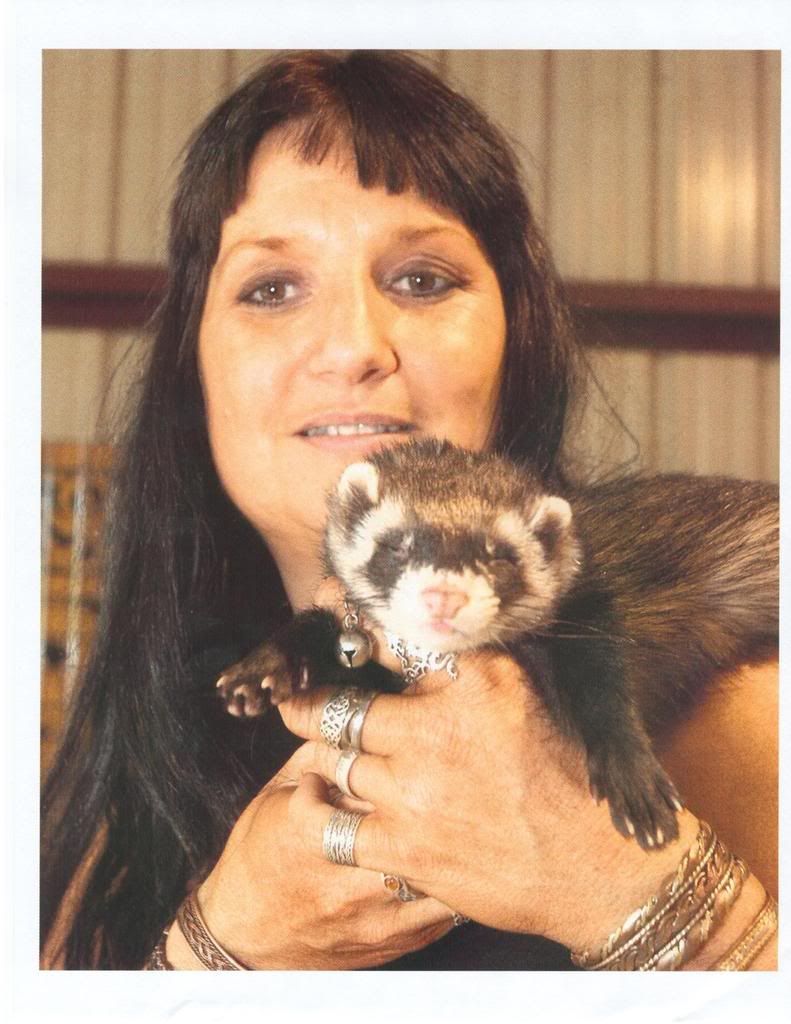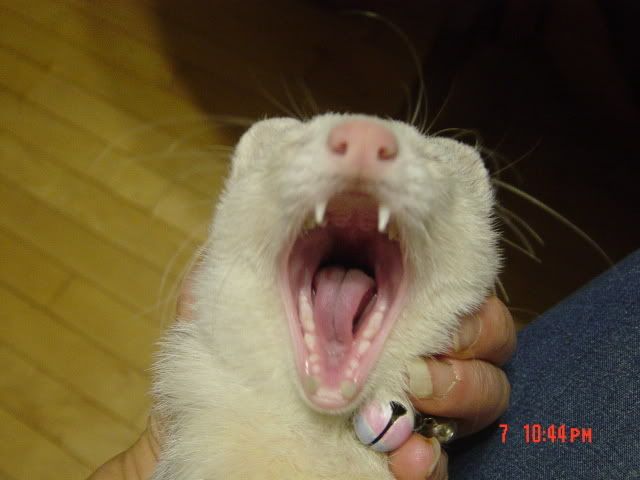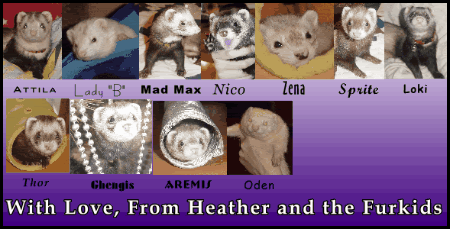Post by fuzzymom on Mar 22, 2010 13:19:29 GMT -5
I am tired of people posting threads promoting a kibble-based diet for cats, dogs, and ferrets. Time and time again I have posted, recommending a raw diet. A while ago I had the idea of a pet care guide to post on the forum, which focuses on a raw diet. This time, I'm going to do it. I want to write up something about the feeding of obligate carnivores, and also have a separate one for the care of ferrets.
This is what I have so far for the feeding of obligate carnivores. It is a rough draft and will be edited and revised a few times before I actually post it. I also want to include pictures, so if you have any to share, I will post what I am looking for. Here is what I have....
Pet food companies will claim their food healthy for your pet. With labels like “Real chicken” and “Wholesome grains” it is hard not to think of how healthy that sounds for our own dietary needs. However, when you have a pet that is considered an obligate carnivore, food is one of the most important decisions you will make about their care. What sounds healthy for a human, may not be the best option for your dog/cat/ferret. Because dogs are not considered to be obligate carnivores, this will focus on cats and ferrets, though dogs can benefit from this information as well. This is meant to inform you, the loving pet parent, about your pet’s dietary needs as an obligate carnivore.
First, the definition of an obligate carnivore. “Animals that depend solely on animal flesh for their nutrient requirements are considered obligate carnivores…..Obligate or true carnivores depend solely on the nutrients found in animal flesh for their survival. While they may consume small amounts of plant material, they lack the physiology required for the efficient digestion of vegetable matter and, in fact, some carnivorous mammals eat vegetation specifically as an emetic. The domestic cat is a prime example of an obligate carnivore, as are all of the other felids.” (Wikipedia - en.wikipedia.org/wiki/Carnivore) Cats, even those of the domestic variety, are considered to be obligate carnivores.
The body of a cat is designed to kill, comsume, and digest animals. The teeth are highly developed to serve the purpose of cutting meat from a prey animal like scissors. The teeth in front are used for the capture of prey. So you may be asking, “How does this influence what kind of food they should eat?” The effects of kibble-based diets on a cat’s teeth can vary. One very common problem is plaque buildup on the surface of the teeth. Because a cat’s teeth are meant to sink into the flesh of their prey, the teeth and gums are cleaned as they are rubbed by the meat. When a cat is fed kibble, this natural, teeth cleaning act, is not performed. Because the kibble is dry, it simply splits as the cat crunches on it. Only the very tips of a cat’s teeth are cleaned when fed a kibble-based diet. This can result in plaque buildup, gingivitis, tooth decay, and bad breath.
Please let me know if there is anything that needs to change, misspelled, information to add to what I've already written. Any changes you think I should make, please write in bold within the document. I plan on taking this one section at a time. I defined what an obligate carnivore is and identified cats and ferrets as being obligate carnivores. The next section is on the teeth of obligate carnivores. How they are designed to work. The effects of kibble-based diets vs the effects of raw diets.
Is there anything I should add to any of those paragraphs? The pictures I need are for the 3rd paragraph. I need pictures of a cat/ferret fed a kibble-based diet showing the effects on their teeth. And I also need a picture of a raw fed pet's teeth.
This is what I have so far for the feeding of obligate carnivores. It is a rough draft and will be edited and revised a few times before I actually post it. I also want to include pictures, so if you have any to share, I will post what I am looking for. Here is what I have....
Pet food companies will claim their food healthy for your pet. With labels like “Real chicken” and “Wholesome grains” it is hard not to think of how healthy that sounds for our own dietary needs. However, when you have a pet that is considered an obligate carnivore, food is one of the most important decisions you will make about their care. What sounds healthy for a human, may not be the best option for your dog/cat/ferret. Because dogs are not considered to be obligate carnivores, this will focus on cats and ferrets, though dogs can benefit from this information as well. This is meant to inform you, the loving pet parent, about your pet’s dietary needs as an obligate carnivore.
First, the definition of an obligate carnivore. “Animals that depend solely on animal flesh for their nutrient requirements are considered obligate carnivores…..Obligate or true carnivores depend solely on the nutrients found in animal flesh for their survival. While they may consume small amounts of plant material, they lack the physiology required for the efficient digestion of vegetable matter and, in fact, some carnivorous mammals eat vegetation specifically as an emetic. The domestic cat is a prime example of an obligate carnivore, as are all of the other felids.” (Wikipedia - en.wikipedia.org/wiki/Carnivore) Cats, even those of the domestic variety, are considered to be obligate carnivores.
The body of a cat is designed to kill, comsume, and digest animals. The teeth are highly developed to serve the purpose of cutting meat from a prey animal like scissors. The teeth in front are used for the capture of prey. So you may be asking, “How does this influence what kind of food they should eat?” The effects of kibble-based diets on a cat’s teeth can vary. One very common problem is plaque buildup on the surface of the teeth. Because a cat’s teeth are meant to sink into the flesh of their prey, the teeth and gums are cleaned as they are rubbed by the meat. When a cat is fed kibble, this natural, teeth cleaning act, is not performed. Because the kibble is dry, it simply splits as the cat crunches on it. Only the very tips of a cat’s teeth are cleaned when fed a kibble-based diet. This can result in plaque buildup, gingivitis, tooth decay, and bad breath.
Please let me know if there is anything that needs to change, misspelled, information to add to what I've already written. Any changes you think I should make, please write in bold within the document. I plan on taking this one section at a time. I defined what an obligate carnivore is and identified cats and ferrets as being obligate carnivores. The next section is on the teeth of obligate carnivores. How they are designed to work. The effects of kibble-based diets vs the effects of raw diets.
Is there anything I should add to any of those paragraphs? The pictures I need are for the 3rd paragraph. I need pictures of a cat/ferret fed a kibble-based diet showing the effects on their teeth. And I also need a picture of a raw fed pet's teeth.




